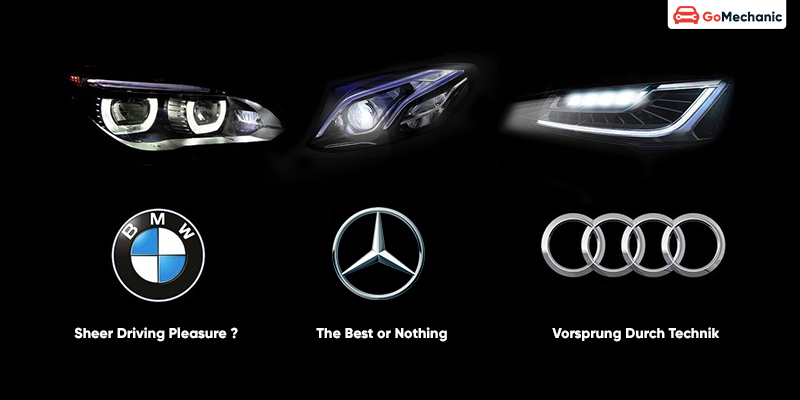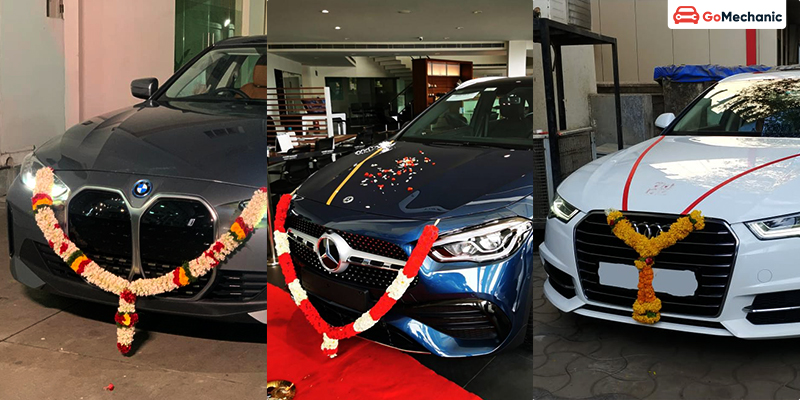When it comes to luxury automobiles in India, there’s a trio that stands out: Audi, BMW, and Mercedes-Benz. These brands have captured the hearts of Indian consumers with their blend of elegance, performance, and status. But what sets them apart in a market as diverse as India’s? Let’s delve into how these German automotive giants are dominating the Indian roads.
Audi in India
- Entry and Establishment (2007): Audi became a part of the Indian luxury car market as a member of the Volkswagen Group, rapidly establishing itself as a leading brand.
- Product Range: Their lineup includes sedans, SUVs, and sports cars tailored to various consumer needs.
- Localization: Focuses on localising the production of certain models to make them more competitively priced against domestic brands.
BMW in India
- Entry and Establishment (2006): BMW marked its entry into India, setting up its foundation a year before Audi and quickly becoming a key player in the luxury car segment.
- Product Range: Offers a variety of luxury sedans, SUVs, and the performance-oriented M series, catering to a wide range of preferences.
- Localization: Has a manufacturing presence in Chennai, which supports its strategy to offer competitively priced premium vehicles.
Mercedes-Benz in India
- Entry and Establishment (1994): As the first luxury car manufacturer to enter India, Mercedes-Benz established a significant early presence and has been leading the segment since.
- Product Range: The brand offers a diverse range of vehicles, including sedans, SUVs, and luxury vans, catering to the high-end market.
- Localization: Utilises its manufacturing plant in Pune to assemble a wide range of vehicles, supporting its strategy for market leadership and innovation in introducing new technologies and models.
Market Analysis: Understanding the Indian Automotive Sector
Growing Demand for Luxury Cars:
- Surge in Demand: Recent years have seen a significant increase in demand for luxury cars in India.
Driving Factors:
- Increasing disposable incomes.
- Growing affluent class.
- Evolving consumer preferences favouring premium products.
- Perception of luxury cars as status symbols and lifestyle choices.
Urbanization and Lifestyle Changes:
- Accelerated urbanisation.
- Cosmopolitan lifestyles.
- Luxury cars are becoming more prevalent in tier-II and tier-III cities.
Desired Features:
- Demand for advanced technology.
- Emphasis on safety features.
- Superior driving experiences.
Competition Landscape:
-
- Intensity and Dynamics: The competition in the luxury car segment is intense and dynamic.
Key Players:
- Audi, BMW, Mercedes-Benz, Jaguar Land Rover, Volvo.
- Each brand offers unique strengths in design, technology, and performance.
Continuous Innovation:
- Brands continuously innovate to stay ahead.
- Introduction of new models, features, and services tailored to the Indian market.
Role of Domestic Players:
- Domestic players like Tata Motors-owned Jaguar Land Rover contribute significantly.
- Offer a diverse range of luxury vehicles to Indian consumers.
- Enrichment by Niche Players: Presence of niche players and emerging electric vehicle manufacturers adds diversity and dynamism to the market.
Brand Identities: Audi, BMW, and Mercedes

Audi: The Pioneers of Innovation
Brand Essence:
- Synonymous with technological innovation and advancement.
- Pride in pioneering spirit, pushing boundaries of automotive technology, design, and performance.
Core Message:
- “Vorsprung durch Technik” – “Progress through Technology.”
- Reflects commitment to developing cutting-edge technologies enhancing driving experience and vehicle efficiency.
Target Audience:
- Appeals to consumers valuing state-of-the-art technology and forward-thinking design.
- Attracts tech-savvy individuals appreciating a blend of performance, innovation, and sleek aesthetics.
BMW: The Ultimate Driving Machine
Brand Essence:
- Stands for dynamic driving pleasure and engineering excellence.
- Emphasises joy of driving, offering vehicles renowned for performance, agility, and precision.
Core Message:
- “The Ultimate Driving Machine.”
- Highlights focus on delivering unparalleled driving experience, superior handling, power, and dynamics.
Target Audience:
- Targets driving enthusiasts prioritising performance and emotional driving experience.
- Appeals to individuals passionate about cars, seeking a blend of luxury, innovation, and sportiness.
Mercedes-Benz: Unmatched Elegance and Luxury
Brand Essence:
- Epitome of luxury and sophistication.
- Known for distinguished design, comfort, and attention to detail, offering unmatched luxury experience.
Core Message:
- Positioning as the pinnacle of automotive luxury, focusing on elegance, craftsmanship, and innovation.
- Emphasises heritage and leadership in creating prestigious vehicles setting standards in luxury, safety, and technology.
Target Audience:
- Appeals to customers valuing sophistication, status, and comfort.
- Attracts affluent individuals seeking vehicles representing success, quality, and refined lifestyle.
Product Portfolio and Segmentation
A brand’s product portfolio and segmentation are vital for its market success. These aspects involve offering a range of vehicles tailored to diverse consumer preferences and effectively targeting specific market segments. This strategic approach helps brands meet consumer needs while staying competitive in the automotive market.
Sedans and SUVs: Core Offerings
Audi: Sedans and SUVs:
- Sedans: A3, A4, A6, A8 – Sleek design and advanced technology.
- SUVs: Q3, Q5, Q7, Q8 – Luxury with versatility, targeting families and adventurers.
BMW: Sedans and SUVs:
- Sedans: 3 Series, 5 Series, 7 Series – Sporty dynamics and premium interiors.
- SUVs: X1, X3, X5, X7 – Spacious, powerful, and capable of off-roading.
Mercedes-Benz: Sedans and SUVs:
- Sedans: C-Class, E-Class, S-Class – Benchmark for luxury and comfort.
- SUVs: GLA, GLC, GLE, GLS – Elegance, safety, and performance in a versatile package.
Electric and Hybrid Options: Embracing Sustainability
Audi e-tron Series:
- Models: e-tron SUV, e-tron GT.
- Features: Efficiency, innovative design.
BMW i Series:
- Models: i3, i8, iX, i4.
- Features: Eco-friendly technology, luxury blend.
Mercedes-Benz EQ Series:
- Models: EQC, EQS.
- Features: Luxury with environmental benefits.
Sales and Growth Trends
Audi: Expanding Market Share
- Trend: Audi has shown a positive trajectory in expanding its market share, attributed to its diverse product range and strategic focus on innovation.
- Growth Drivers: The introduction of new models tailored for the Indian market and the emphasis on technological advancements have been key factors.
BMW: Capturing Diverse Consumer Segments
- Trend: BMW has effectively captured a wide range of consumer segments, from performance enthusiasts to luxury seekers.
- Growth Drivers: A balanced portfolio of sedans, SUVs, and electric vehicles, alongside a reputation for driving dynamics and luxury, has fueled its growth.
Mercedes-Benz: Setting New Standards of Excellence
- Trend: Mercedes-Benz continues to set new standards in the luxury car market, maintaining its leadership through continuous innovation.
- Growth Drivers: The brand’s focus on luxury, cutting-edge technology, and expanding its electric vehicle offerings have strengthened its market position.
Marketing Strategies
Marketing strategies are vital components of a brand’s success, encompassing various tactics to promote products, engage customers, and boost brand visibility in a competitive market.
Digital Presence: Leveraging Social Media and Online Platforms
Audi:
- Strategy: Audi strategically utilises social media and online platforms to fortify its digital presence.
- Platforms: Facebook, Instagram, Twitter serve as channels to showcase Audi’s products, share brand stories, and engage with customers.
- Digital Marketing: Audi employs targeted advertisements, personalised messages to enhance brand visibility online.
BMW:
- Strategy: BMW maximises its digital presence by effectively leveraging social media and online platforms.
- Platforms: Facebook, Instagram, Twitter are utilised to highlight BMW’s product lineup, convey brand narratives, and engage with the audience.
- Digital Marketing: BMW delivers tailored ads, personalised content to broaden its brand exposure in the digital realm.
Mercedes-Benz:
- Strategy: Mercedes-Benz amplifies its digital presence through social media and online platforms.
- Platforms: Facebook, Instagram, Twitter are leveraged to showcase Mercedes-Benz vehicles, share brand stories, and interact with customers.
- Digital Marketing: Mercedes-Benz employs precise advertisements, customised messaging to elevate brand visibility online.
Customer Engagement Initiatives: Creating Memorable Experiences

Test Drive Events:
- Personalised Experiences: Tailoring test drives to align with individual preferences and lifestyles.
- Exclusive Routes: Utilising unique and scenic driving routes to highlight vehicle performance.
Brand Experiences:
- Factory Tours and Museums: Offering insight into the brand’s heritage and craftsmanship.
- Technology Showcases: Demonstrating innovation and technological advancements in exclusive events.
Exclusive VIP Events:
- Launch Events: Celebratory unveilings of new models with high-profile attendees.
- Lifestyle Events: Sponsoring events that align with the luxury lifestyle of the brand’s clientele.
Loyalty Programs:
- Membership Benefits: Providing perks such as priority service and exclusive event invitations to repeat customers.
- Referral Rewards: Incentivizing word-of-mouth marketing through referral benefits.
Impact and Benefits:
- Brand Loyalty: Deepening emotional connections with the brand for long-term loyalty.
- Word-of-Mouth: Leveraging satisfied customers as brand ambassadors.
- Differentiation: Standing out in a competitive market through unique experiences.
- Community Building: Fostering a sense of exclusivity and community among customers.
Challenges and Opportunities
The luxury car segment, while lucrative and symbolising status and innovation, faces its own set of challenges and opportunities. As brands like Audi, BMW, and Mercedes-Benz navigate through these, they must balance between regulatory compliance and adapting to evolving market demands. Here’s a closer look at these aspects:
Challenges
Regulatory Hurdles
- Taxation: High tax rates elevate costs, impacting accessibility and sales.
- Import Regulations: Quotas and strict standards necessitate significant compliance efforts.
Emerging Trends
- Changing Consumer Preferences: Shifts towards sustainability, digitalization, and personalization.
- Technology Adoption: Need for continuous investment in R&D for electric powertrains and autonomous features.
Opportunities
Overcoming Regulatory Hurdles
- Localization: Manufacturing locally to mitigate import duties and taxes.
- Sustainability Initiatives: Leading in green technology to meet environmental regulations.
Leveraging Emerging Trends
- Electric Vehicles (EVs): Capitalising on the rising demand for luxury EVs.
- Digital Services: Enhancing customer experience through digitalization.
- Experience Economy: Creating unique experiences to foster brand loyalty and attract new customers.
Future Outlook: Sustaining Leadership in the Indian Market
To sustain leadership in the Indian luxury car market, brands like Audi, BMW, and Mercedes-Benz need to focus on several key strategies:
Electrification and Sustainability
- Expand EV Lineup: Introduce more electric and hybrid models to meet growing demand.
- Sustainable Practices: Emphasise eco-friendly manufacturing and operations.
Digital and Technological Innovation
- Enhance Digital Sales: Develop online sales platforms and virtual showrooms.
- Invest in Tech: Incorporate connected, autonomous, and smart vehicle technologies.
Regulatory Adaptation and Localization
- Manufacture Locally: Reduce costs by expanding local production.
- Stay Regulatory Compliant: Adapt to India’s evolving emissions and safety regulations.
Customer Experience and Loyalty
- Unique Brand Experiences: Offer memorable brand experiences both online and offline.
- Exceptional After-Sales Service: Prioritise customer service to ensure satisfaction and loyalty.
Customization and Market Understanding
- Offer Customization: Allow personalization of vehicles to suit individual tastes.
- Understand Local Preferences: Tailor products and marketing to the Indian consumer’s tastes.
Community Engagement and CSR
- Build Brand Communities: Foster a sense of belonging among customers through events and clubs.
- Engage in CSR: Participate in social responsibility initiatives to enhance brand image.
Conclusion
The blog illustrates how Audi, BMW, and Mercedes-Benz have become leaders in the Indian luxury car market through strategic localization, embracing digital innovation, and focusing on customer engagement. Despite challenges like regulatory hurdles and shifting consumer preferences, these brands have capitalised on opportunities in electrification, digital services, and creating memorable customer experiences. Sustaining their market leadership in India hinges on continuing innovation, adapting to emerging trends, and maintaining a strong customer focus.





